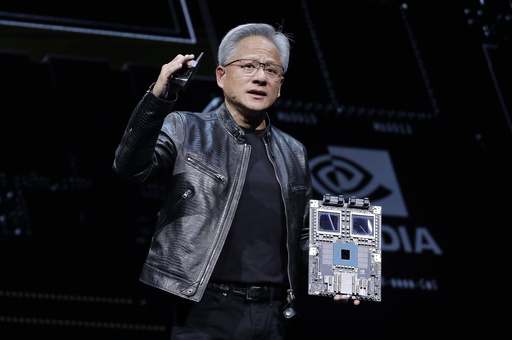Nvidia shares rebounded Tuesday, halting a three-day skid that had surprised many investors and wiped away more than $400 billion in market value.
Early last week, Nvidia overtook Microsoft as Wall Street’s most valuable public company. Then it fell 13% over three days, its worst such stretch since 2022. Because Nvidia has become so massive in size, the movements for its stock carry extra weight on the S&P 500 and other indexes.
Any stock that climbs as much as Nvidia has — up more than 1,000% since the autumn of 2022 — is vulnerable to some of its investors selling shares in order to lock in some profits. That earlier run makes a 13% drop over three days look like a relative trifle.
Monday, Nvidia shares rose 6.8%, bringing its market value to $3.10 trillion, behind Microsoft at $3.35 trillion and Apple at $3.21 trillion.
Those three companies and a few others are responsible for much of the S&P 500’s returns recently. Investors would prefer a market where many stocks are participating in the gains.
There’s been nearly insatiable demand for Nvidia’s chips to power artificial intelligence applications and the company has played a big role in the U.S. stock market’s recent record runs even as the economy’s growth slows under the weight of high interest rates. But the AI boom is moving at such a rapid pace that it’s raised worries about a possible bubble in the stock market and too-high expectations among investors.
Derren Nathan, head of equity research at Hargreaves Lansdown, said in a statement that while Nvidia’s stock has declined in recent days, one must also look at the bigger picture.
“The shares have still gained 190% on a 12-month view, so it’s no surprise some investors are locking in some profits,” he said.
Nathan also isn’t concerned about potential wider spread implications. “Although Nvidia has sneezed, the wider market hasn’t caught a cold with a mixture of less extreme movements in both directions for the rest of the Magnificent 7,” he said.
The Magnificent 7, which include Alphabet, Amazon, Apple, Meta Platforms, Microsoft, Nvidia and Tesla, are a small group of stocks that are responsible for a big chunk of the U.S. stock market’s total return.
Some critics say Nvidia still looks expensive. Its stock is trading at a price that’s 73 times higher than the profit that it’s produced over the last 12 months. That makes it look much more expensive than the broad S&P 500 index, where companies are trading at just 26 times their overall earnings. That itself looks pricey to skeptics, who say the broad U.S. stock market looks expensive compared with history.
The thing Nvidia has going for it is the possibility of continued, incredible growth as it ushers in a new era that proponents say will remake the economy.
Based on its expected profit over the next 12 months, Nvidia is trading at a still expensive but more reasonable price-earnings ratio of roughly 40. And if generative AI hardware deployments are still only in year two of what could be a three-to-five year deployment cycle, as analysts at Bank of America suggest, the possible runway of growth could make it look even more compelling.
Analysts estimate that the company’s revenue for the fiscal year that ends in January 2025 will reach $119.9 billion — about double its revenue for fiscal 2024 and more than four times its receipts the year before that.
__
Associated Press Business Writer Stan Choe in New York contributed to this report.
This website uses cookies so that we can provide you with the best user experience possible. Cookie information is stored in your browser and performs functions such as recognising you when you return to our website and helping our team to understand which sections of the website you find most interesting and useful.
